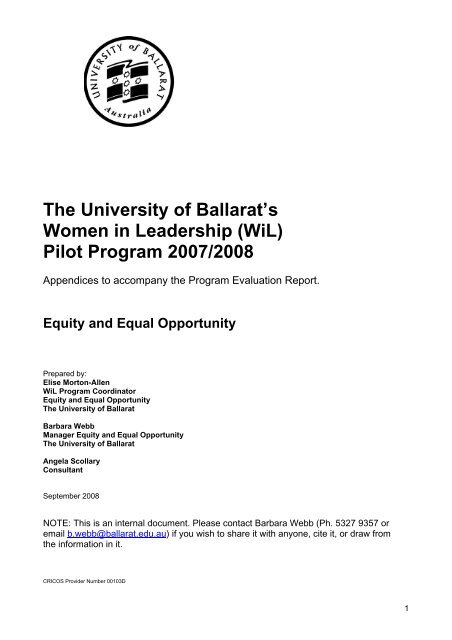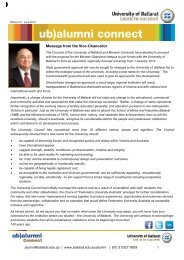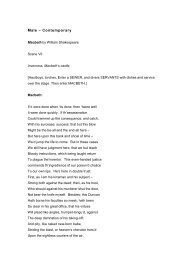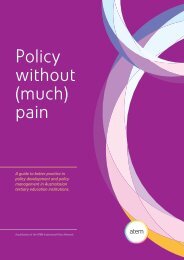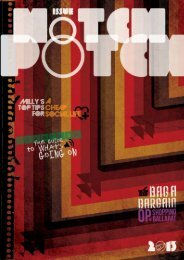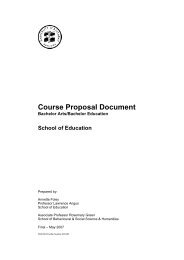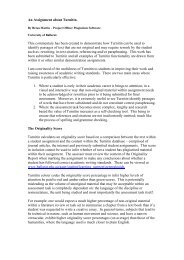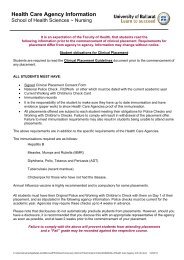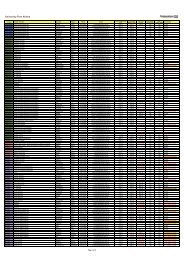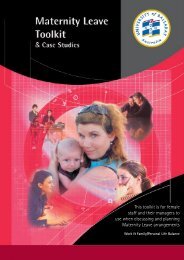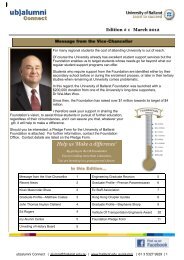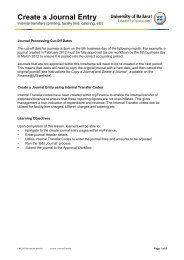UB's Women in Leadership Pilot Program, 2007/2008 Evaluation ...
UB's Women in Leadership Pilot Program, 2007/2008 Evaluation ...
UB's Women in Leadership Pilot Program, 2007/2008 Evaluation ...
You also want an ePaper? Increase the reach of your titles
YUMPU automatically turns print PDFs into web optimized ePapers that Google loves.
18. Can’t see ANYONE travell<strong>in</strong>g – eg for an hour for this.19. Not a clear def<strong>in</strong>ition or understand<strong>in</strong>g of ‘leadership’.20. Isolation – the western staff are often left out of the equation eg Ballarat meet<strong>in</strong>gs start at9am – ignorant of the needs of Western staff. Meet<strong>in</strong>gs at Horsham start at 11am –responsive.21. ½ day m<strong>in</strong>imum for sessions to one day.22. Teachers aren’t allowed to cancel classes. Would need a ‘directive’ to enable attendance.23. If have ‘set’ times – disenfranchise one group who are teach<strong>in</strong>g that day.24. If set times early enough – could feed <strong>in</strong>to timetabl<strong>in</strong>g25. Issues for part-timers.5
Appendix 2 – Members of the <strong>2007</strong>/<strong>2008</strong> WiL Steer<strong>in</strong>g CommitteeDarren Holland, Vice President, Student and Learn<strong>in</strong>g SupportJulianne Krusche, Teacher, School of Human ServicesGayle Richards, Adm<strong>in</strong>istrative Manager, School of Human Movement and Sport SciencesSally Wellard, Professor, School of Nurs<strong>in</strong>gDeborah Walker, (Act<strong>in</strong>g) Director Human ResourcesBarbara Webb, Manager Equity and Equal OpportunityGlenice Wood, Senior Lecturer, School of Bus<strong>in</strong>essVirg<strong>in</strong>ia Fenelon, Director, Institute of Professional and Organisational Learn<strong>in</strong>g.6
Appendix 3 – <strong>2007</strong>/<strong>2008</strong> WiL <strong>Program</strong> BudgetThis page has not been <strong>in</strong>cluded for privacy reasons (e.g., <strong>in</strong> relation to staff<strong>in</strong>g salaries) andbecause it conta<strong>in</strong>s commercial “<strong>in</strong> confidence” <strong>in</strong>formation.7
Appendix 4 - UB <strong>Women</strong> <strong>in</strong> <strong>Leadership</strong> (WiL) <strong>Program</strong>, <strong>2007</strong>/<strong>2008</strong>:Participant Application Form.Please type your answers <strong>in</strong>to the spaces provided. Spaces will automaticallyexpand, but responses to the questions on this page should not exceed 2 pages.NamePhone (work)Phone(alternate)EmailClassification egHEW 7, TAFE SE1,ACAD BSchool/SectionCampusWhat leadershipexperience (formaland/or <strong>in</strong>formal) do youhave?How wouldparticipat<strong>in</strong>g <strong>in</strong> the WiLprogram assist you <strong>in</strong>your current role(s) atUB (please answerwith reference to theprogram goals andobjectives)?How wouldparticipat<strong>in</strong>g <strong>in</strong> the WiLprogram assist you <strong>in</strong>reach<strong>in</strong>g yourleadership goals andaspirations at UB(please answer withreference to theprogram goals andobjectives)?8
WiL <strong>Program</strong> Applicant:I, the WiL <strong>Program</strong> applicant (name:_______________________________) of The Universityof Ballarat understand that if my application to take part <strong>in</strong> the <strong>Women</strong> <strong>in</strong> <strong>Leadership</strong> <strong>Program</strong><strong>2007</strong>/<strong>2008</strong> is successful, I will be required to: Participate <strong>in</strong> the core program consist<strong>in</strong>g of eight full-day workshop sessions (dateslisted below) and complete learn<strong>in</strong>g activities and projects <strong>in</strong>tegral to these workshops. Travel to attend the core program workshops if required (Note: most, if not all,workshops will be held at Ballarat locations depend<strong>in</strong>g on participant locations. Stafffrom Western campuses will be supported with travel and accommodation <strong>in</strong> Ballarat). Participate <strong>in</strong> any of the three <strong>2008</strong> optional program workshops that I choose to attend(dates to be announced). Participate <strong>in</strong> a program evaluation by provid<strong>in</strong>g written and verbal feedback about theprogram and my experience of tak<strong>in</strong>g part <strong>in</strong> it.Signature:________________________Manager/supervisor of Applicant:I, (name:_________________________________) the supervisor/manager of(name of program applicant:_________________________________) agree to support this<strong>in</strong>dividual’s <strong>in</strong>volvement <strong>in</strong> the WiL program if her application is successful. I understand that <strong>in</strong>order to participate <strong>in</strong> the program, she will need to attend eight full-day workshop sessions onthe dates below and may also attend up to three additional program sessions dur<strong>in</strong>g <strong>2008</strong>(dates to be announced). I also understand that UB will support staff from Western campuseswith travel and accommodation <strong>in</strong> Ballarat if this is required to participate <strong>in</strong> the programworkshops.Statement of support from manager/supervisor of applicant:Please <strong>in</strong>sert a statement of support/endorsement here and sign below.Signature:________________________9
WiL <strong>Program</strong> Dates:<strong>2007</strong> Core workshops (9.30am to 4.30pm):Workshop 1: Thurs. 13 th Sept.Workshop 2: Thurs. 25 th Oct.Workshop 3: Thurs. 29 th Nov.<strong>2008</strong> Core workshops (9.30am to 4.30pm):Workshop 4: Thurs. 7 th Feb.Workshop 5: Thurs. 6 th Mar.Workshop 6: Thurs. 10 th Apr.Workshop 7: Thurs. 8 th May.Workshop 8: Thurs. 5 th Jun.Up to three additional optional sessions, <strong>2008</strong>:Dates to be announced.APPLICATIONS CLOSE 5PM MONDAY THE 30 TH OF JULY, <strong>2007</strong>.Post Application Form to:Attention: Elise Morton-Allen<strong>Women</strong> <strong>in</strong> leadership <strong>Program</strong>c/- Equity and Equal Opportunity,Mt Helen.Applicants will be notified of the outcome of the selection process via email and/orphone dur<strong>in</strong>g August.Thank-you for your <strong>in</strong>terest <strong>in</strong> the UB WiL <strong>Program</strong>.10
Appendix 5 – WiL Questionnaires<strong>Women</strong> <strong>in</strong> <strong>Leadership</strong> (WiL) <strong>Program</strong> <strong>2007</strong>/<strong>2008</strong>: <strong>Evaluation</strong> of Workshop 1 1Date: Thursday September 13, <strong>2007</strong>.Topic: <strong>Program</strong> Introduction & <strong>Leadership</strong> Styles.Please type your answers <strong>in</strong>to the spaces provided (areas shaded <strong>in</strong> grey). Spaces willautomatically expand.Question 1. Name?Please note that only staff <strong>in</strong>volved <strong>in</strong> runn<strong>in</strong>g the <strong>Women</strong> <strong>in</strong> <strong>Leadership</strong> (WiL) <strong>Program</strong> will have access to thisquestionnaire once completed. This <strong>in</strong>formation will be used to help us ensure that future workshops meet theprofessional development needs of women at UB. If any <strong>in</strong>formation from this questionnaire is fed back to theUniversity, it will be de-identified.Answer 1:Question 2. Which parts of the workshop did you f<strong>in</strong>d most useful and relevant to you <strong>in</strong> your work?Answer 2:Question 3. Which parts of the workshop were most useful and relevant to you as a person?Answer 3:Question 4. Workshop content, delivery and facilitation.Please comment on:a) The opportunities provided for <strong>in</strong>teraction and participation <strong>in</strong> the workshop.b) The ways <strong>in</strong> which the workshop met or did not meet your learn<strong>in</strong>g needs/expectations.c) The ways <strong>in</strong> which Julie’s style of facilitat<strong>in</strong>g the workshop suited or did not suit yourlearn<strong>in</strong>g needs/expectations?d) The appropriateness and usefulness of the materials provided and/or activities completeddur<strong>in</strong>g the workshop.Answer 4:a)b)c)d)Question 5. Please comment on the venue and cater<strong>in</strong>g.Answer 5:Question 6. On a scale of one to ten, where 1 is least satisfactory and 10 is most satisfactory, pleasehighlight the score which best describes your op<strong>in</strong>ion of this workshop.Answer 6: 10 9 8 7 6 5 4 3 2 1Q7. Other comments.Answer 7:THANK YOU FOR TAKING PART IN THE WORKSHOP AND FOR COMPLETING THIS QUESTIONAIRE. Pleaseemail it to Elise Morton-Allen at:e.morton-allen@ballarat.edu.au.1 Nb: Questionnaires adm<strong>in</strong>istered after each <strong>in</strong>dividual workshop were the same or very similar to thisquestionnaire.11
<strong>Women</strong> <strong>in</strong> <strong>Leadership</strong> Post-<strong>Program</strong> Survey for Participants(Please click on Select and choose appropriate response)~ Your staff group SelectWhich sessions of the <strong>Program</strong> as listed below were you able to attend? (Click on relevantboxes)~ Introduction & <strong>Leadership</strong> Styles September 13, <strong>2007</strong> (Alexandria’s)~ Emotional Intelligence October 25, <strong>2007</strong> (Alexandria’s)~ Team <strong>Leadership</strong> & Assertion November 29, <strong>2007</strong> (Alexandria’s)~ Manag<strong>in</strong>g Change February 7, <strong>2008</strong> (Alexandria’s)~ Conflict, Power & Career Paths (<strong>in</strong>c. guest speakers) March 6, <strong>2008</strong>(Ballarat Lodge)~ Career Development & Life Balance April 10, <strong>2008</strong> (Gum San, Ararat)~ Mak<strong>in</strong>g a Difference (guest speakers) May 8, <strong>2008</strong> (Alexandria’s)~ Optional Workshop on Governance May 22, <strong>2008</strong> (half day, GreenhillEnterprise Centre)~ <strong>Program</strong> Conclusion June 5, <strong>2008</strong> (Alexandria’s)~ Attended as an observer at Academic Board meet<strong>in</strong>g~ Attended as an observer at Council meet<strong>in</strong>g12
PROGRAM OUTCOMESPlease click on ‘Select’ and choose appropriate response. Where relevant, we would greatlyappreciate any examples you can give of the ways <strong>in</strong> which the program assisted orempowered you and additional comments/clarifications of your responses. Please writethese examples/comments <strong>in</strong> the grey-coloured space provided under each question.How HELPFUL was participat<strong>in</strong>g <strong>in</strong> the WiL program <strong>in</strong> empower<strong>in</strong>g or assist<strong>in</strong>g you to:~ understand and build on your leadership style~ Examples/Comments…~ understand that there are many different yet effective leadership styles and approaches~ Examples/Comments…~ understand the leadership styles of others and use this understand<strong>in</strong>g to work with themmore effectively~ Examples/Comments…~ ga<strong>in</strong> clarity about your career direction and/or leadership development goals~ Examples/Comments…~ develop strategies for achiev<strong>in</strong>g your career and/or leadership development goals~ Examples/Comments…~ further develop the skills and/or confidence to assert your needs, wants and op<strong>in</strong>ions atwork~ Examples/Comments…~ further develop the skills to communicate and negotiate effectively with other staffmembers~ Examples/Comments…~ understand, value and utilise your emotional sensitivity and awareness <strong>in</strong> your work~ Examples/Comments…~ acknowledge, discuss and take steps towards resolv<strong>in</strong>g conflict <strong>in</strong> the workplace~ Examples/Comments…~ deal with <strong>in</strong>terpersonal problems <strong>in</strong>volv<strong>in</strong>g your colleagues and/or managers~ Examples/Comments…~ help establish/promote/support positive change <strong>in</strong> the workplace~ Examples/Comments…~ take steps towards achiev<strong>in</strong>g a work-life balance that you feel relatively comfortable with~ Examples/Comments…~ have a better understand<strong>in</strong>g of the roles and perspectives of staff from different sectorswith<strong>in</strong> the University (e.g. TAFE, Higher Ed., and General staff)~ Examples/Comments…SelectSelectSelectSelectSelectSelectSelectSelectSelectSelectSelectSelectSelect13
How HELPFUL was participat<strong>in</strong>g <strong>in</strong> the WiL program <strong>in</strong> empower<strong>in</strong>g or assist<strong>in</strong>g you to:~ have a clearer understand<strong>in</strong>g of the overall structure, practices, policies andorganisational culture of UB~ Examples/Comments…~ develop or broaden your network with colleagues~ Examples/Comments…~ ga<strong>in</strong> support, encouragement or advice from others which helped you <strong>in</strong> your work~ Examples/Comments…~ direct or lead projects and/or teams~ Examples/Comments…~ manage staff or take a leadership role <strong>in</strong> deal<strong>in</strong>g with your colleagues~ Examples/Comments…~ <strong>in</strong>fluence the direction of decisions and/or policy~ Examples/Comments…~ contribute to and/or <strong>in</strong>fluence meet<strong>in</strong>gs~ Examples/Comments…~ take steps toward participat<strong>in</strong>g <strong>in</strong> or contribut<strong>in</strong>g to University committees/forums/boards~ Examples/Comments…~ ga<strong>in</strong> a better understand<strong>in</strong>g of how important decisions are made with<strong>in</strong> the Universityand how to become <strong>in</strong>volved <strong>in</strong> these decision-mak<strong>in</strong>g processes~ Examples/Comments…~ employ strategies for succeed<strong>in</strong>g <strong>in</strong> ‘male dom<strong>in</strong>ant’ situations without compromis<strong>in</strong>g onvalues that are important to you~ Examples/Comments…~ take steps toward seek<strong>in</strong>g a promotion, reclassification or leadership role~ Examples/Comments…~ take steps toward ensur<strong>in</strong>g that your skills and abilities are better utilised <strong>in</strong> your workrole~ Examples/Comments…~ look for opportunities to contribute more as a leader with<strong>in</strong> your current role at UB~ Examples/Comments…~ look for opportunities to take on more formal and/or <strong>in</strong>formal leadership roles~ Examples/Comments…~ become more visible <strong>in</strong> the UB community as a leader/potential leader~ Examples/Comments…~ ga<strong>in</strong> more recognition or understand<strong>in</strong>g from members of the UB community of yourstrengths/abilities/achievements~ Examples/Comments…SelectSelectSelectSelectSelectSelectSelectSelectSelectSelectSelectSelectSelectSelectSelectSelect~ Other: Please tell us any other benefits/outcomes that have resulted for you from participat<strong>in</strong>g <strong>in</strong> the<strong>Program</strong>How HELPFUL was the WiL program <strong>in</strong> assist<strong>in</strong>g or encourag<strong>in</strong>g:~ improved communication between UB staff <strong>in</strong> different sectors, schools, sections,portfolios or campuses.~ Examples/Comments…Select14
~ improved cooperation between UB’s different sectors, schools, sections, portfoliosor campuses~ Examples/Comments…~ greater shar<strong>in</strong>g of knowledge and <strong>in</strong>formation between staff from different sectors,schools, sections, portfolios or campuses~ Examples/Comments…~ the foster<strong>in</strong>g/development of skilled women leaders at UB~ Examples/Comments…~ organisational growth through capitalis<strong>in</strong>g on the strengths and abilities of femalestaff~ Examples/Comments…~ the development of a progressive or “forward-mov<strong>in</strong>g” culture at UB~ Examples/Comments…~ the development of a diverse and gender-<strong>in</strong>clusive culture at UB~ Examples/Comments…SelectSelectSelectSelectSelectSelect~ Other: Please tell us any other benefits/outcomes you feel the WiL <strong>Program</strong> has had for the University orwhich the <strong>Program</strong> may have if it was cont<strong>in</strong>ued <strong>in</strong> the future15
PROGRAM DESIGN & DELIVERYTo what extent do you AGREE or DISAGREE with the follow<strong>in</strong>g statements?~ The <strong>Program</strong> was well organised/coord<strong>in</strong>ated overall~ Comment:~ I was happy with the <strong>Program</strong> overall~ Comment:~ The <strong>Program</strong> should be offered aga<strong>in</strong> at UB~ Comment:Please comment below on the MIX OF PARTICIPANTS <strong>in</strong> the WiL <strong>Program</strong>:SelectSelectSelect~ What <strong>in</strong>fluence did the <strong>in</strong>clusion of Higher Ed., TAFE and General staff have on:a) your experience of the <strong>Program</strong>?b) the group dynamics?~ What <strong>in</strong>fluence did the <strong>in</strong>clusion of staff from a range of seniority levels have on:a) your experience of the <strong>Program</strong>?b) the group dynamics?~ What <strong>in</strong>fluence did hav<strong>in</strong>g only women participants have on:a) your experience of the <strong>Program</strong>?b) the group dynamics?~ What <strong>in</strong>fluence did complet<strong>in</strong>g the whole <strong>Program</strong> with the one group of people have on:*a) your experience of the <strong>Program</strong>?b) the group dynamics?*Note: The alternative would be to have different groups of people attend some or all of the workshops.If the <strong>Program</strong> was offered aga<strong>in</strong> <strong>in</strong> the future, do you have any SUGGESTIONS FOR MODIFICATIONS <strong>in</strong>the follow<strong>in</strong>g areas:~ DESIGN/CONTENT~ the application process~ the mix of staff participat<strong>in</strong>g <strong>in</strong> the <strong>Program</strong>~ the range and depth of topics covered <strong>in</strong> workshops~ the tim<strong>in</strong>g or schedul<strong>in</strong>g of the workshops~ the overall design of the <strong>Program</strong> (i.e., 8 full-day, compulsory workshops withone optional workshop on Governance & opportunities to observeCouncil/Academic Board meet<strong>in</strong>gs offered to women-only, over 8 months)~ FACILITATION~ the facilitation approach/methods used <strong>in</strong> workshops~ the activities undertaken <strong>in</strong> workshops to facilitate learn<strong>in</strong>g~ OTHER suggestions for modifications to the <strong>Program</strong>16
Below are some IDEAS FOR POSSIBLE CHANGES to the WiL <strong>Program</strong> which we would like your <strong>in</strong>put on:~ Should a formal mentor<strong>in</strong>g component be added to the <strong>Program</strong> (note: this would <strong>in</strong>volvearrang<strong>in</strong>g a mentor from the University to regularly meet with and support/advise eachWiL participant)?~ Why/why not?~ If yes, do you have any ideas/suggestions for how we could best implement this?~ Should further optional workshops be added to the <strong>Program</strong>?~ If yes, please list possible topics for these workshops:~ Should compulsory work-based follow-up exercises be added to the <strong>Program</strong> to assistparticipants <strong>in</strong> apply<strong>in</strong>g their learn<strong>in</strong>g to the workplace?~ Why/why not?~ If yes, do you have any ideas/suggestions for how we could best implement this?~ Should the <strong>Program</strong> be accredited and form part of an exist<strong>in</strong>g formal qualification(please note, <strong>in</strong> order for this to occur, a formal assessment task would need to beundertaken by participants)?~ Why/why not?~ If yes, do you have any ideas/suggestions for how we could best implement this?~ Should some k<strong>in</strong>d of group activity or project be <strong>in</strong>cluded <strong>in</strong> the <strong>Program</strong> to helpparticipants apply their learn<strong>in</strong>g (<strong>in</strong> some ways, the participant presentation/lunch withthe VC became a group activity/project <strong>in</strong> the pilot <strong>Program</strong> but should someth<strong>in</strong>g moreformalised be <strong>in</strong>cluded <strong>in</strong> the future)?~ Why/why not?~ If yes, do you have any ideas/suggestions for how we could best implement this?Do you have ANY OTHER IDEAS/SUGGESTIONS regard<strong>in</strong>g how we could help ensure that:SelectSelectSelectSelectSelect~ participants become more visible/raised <strong>in</strong> profile to colleagues and senior managers as leaders orpotential leaders while they are complet<strong>in</strong>g the <strong>Program</strong>?~ participants apply their learn<strong>in</strong>gs from the <strong>Program</strong> <strong>in</strong> their work environment?~ senior staff and managers at the University are engaged with and supportive of the <strong>Program</strong>?~ the <strong>Program</strong> leads to positive outcomes for the University (e.g., organisational growth, strengthenedleadership and cultural change)?OPTIONAL COMMENTSAny further <strong>in</strong>formation / suggestions /comments you would like to contributePlease Comment…17
<strong>Women</strong> <strong>in</strong> <strong>Leadership</strong> Post-<strong>Program</strong> Survey for FacilitatorPlease type your answers <strong>in</strong>to the grey-coloured areas after each question.PROGRAM DESIGN & DELIVERYPlease comment below on the MIX OF PARTICIPANTS <strong>in</strong> the WiL <strong>Program</strong>:~ What <strong>in</strong>fluence did the <strong>in</strong>clusion of Higher Ed., TAFE and General staff have on:a) your experience of facilitat<strong>in</strong>g the <strong>Program</strong>?b) the group dynamics?~ What <strong>in</strong>fluence did the <strong>in</strong>clusion of staff from a range of seniority levels have on:a) your experience of facilitat<strong>in</strong>g the <strong>Program</strong>?b) the group dynamics?~ What <strong>in</strong>fluence did hav<strong>in</strong>g only women participants have on:a) your experience of facilitat<strong>in</strong>g the <strong>Program</strong>?b) the group dynamics?~ What <strong>in</strong>fluence did complet<strong>in</strong>g the whole <strong>Program</strong> with the one group of participants have on:*a) your experience of facilitat<strong>in</strong>g the <strong>Program</strong>?b) the group dynamics?*Note: The alternative would be to have different groups of people attend some or all of the workshops.If the <strong>Program</strong> was offered aga<strong>in</strong> <strong>in</strong> the future, do you have any SUGGESTIONS FOR MODIFICATIONS <strong>in</strong>the follow<strong>in</strong>g areas:Nb: Julie, if you have different responses depend<strong>in</strong>g on whether it would be you as facilitator or adifferent person, you might like to make that clear.~ DESIGN/CONTENT~ the application process~ the mix of staff participat<strong>in</strong>g <strong>in</strong> the <strong>Program</strong>~ the range and depth of topics covered <strong>in</strong> workshops~ the tim<strong>in</strong>g or schedul<strong>in</strong>g of the workshops~ the overall design of the <strong>Program</strong> (i.e., 8 full-day, compulsory workshops withone optional workshop on Governance & opportunities to observeCouncil/Academic Board meet<strong>in</strong>gs offered to women-only, over 8 months)~ FACILITATION~ the facilitation approach/methods used <strong>in</strong> workshops~ the activities undertaken <strong>in</strong> workshops to facilitate learn<strong>in</strong>g~ OTHER suggestions for modifications to the <strong>Program</strong>18
Below are some IDEAS FOR POSSIBLE CHANGES to the WiL <strong>Program</strong> which we would like your <strong>in</strong>put on:Please click on ‘Select’ and choose appropriate response. Answers to subsequentquestions can be typed <strong>in</strong>to the grey-coloured areas after each question.~ Should a formal mentor<strong>in</strong>g component be added to the <strong>Program</strong> (note: this would <strong>in</strong>volvearrang<strong>in</strong>g a mentor from the University to regularly meet with and support/advise eachWiL participant)?~ Why/why not?~ If yes, do you have any ideas/suggestions for how we could best implement this?~ Should further optional workshops be added to the <strong>Program</strong>?~ If yes, please list possible topics for these workshops:~ Should compulsory work-based follow-up exercises be added to the <strong>Program</strong> to assistparticipants <strong>in</strong> apply<strong>in</strong>g their learn<strong>in</strong>g to the workplace?~ Why/why not?~ If yes, do you have any ideas/suggestions for how we could best implement this?~ Should the <strong>Program</strong> be accredited and form part of an exist<strong>in</strong>g formal qualification(please note, <strong>in</strong> order for this to occur, a formal assessment task would need to beundertaken by participants)?~ Why/why not?~ If yes, do you have any ideas/suggestions for how we could best implement this?~ Should some k<strong>in</strong>d of group activity or project be <strong>in</strong>cluded <strong>in</strong> the <strong>Program</strong> to helpparticipants apply their learn<strong>in</strong>g (<strong>in</strong> some ways, the participant presentation/lunch withthe VC became a group activity/project <strong>in</strong> the pilot <strong>Program</strong> but should someth<strong>in</strong>g moreformalised be <strong>in</strong>cluded <strong>in</strong> the future)?~ Why/why not?~ If yes, do you have any ideas/suggestions for how we could best implement this?Do you have ANY OTHER IDEAS/SUGGESTIONS regard<strong>in</strong>g how we could help ensure that:SelectSelectSelectSelectSelect~ participants become more visible/raised <strong>in</strong> profile to colleagues and senior managers as leaders orpotential leaders while they are complet<strong>in</strong>g the <strong>Program</strong>?~ participants apply their learn<strong>in</strong>gs from the <strong>Program</strong> <strong>in</strong> their work environment?~ senior staff and managers at the University are engaged with and supportive of the <strong>Program</strong>?~ the <strong>Program</strong> leads to positive outcomes for the University (e.g., organisational growth, strengthenedleadership and cultural change)?Any further <strong>in</strong>formation / suggestions /comments you would like to contribute?19
<strong>Women</strong> <strong>in</strong> <strong>Leadership</strong> Post-<strong>Program</strong> Survey for Steer<strong>in</strong>g CommitteePlease type your answers <strong>in</strong>to the grey-coloured areas after each question.If the <strong>Program</strong> was offered aga<strong>in</strong> <strong>in</strong> the future, do you have any SUGGESTIONS FOR MODIFICATIONS <strong>in</strong> the follow<strong>in</strong>gareas:~ DESIGN / CONTENT / FACILITATION~ the application process~ the mix of staff participat<strong>in</strong>g <strong>in</strong> the <strong>Program</strong>~ the range and depth of topics covered <strong>in</strong> workshops~ the tim<strong>in</strong>g or schedul<strong>in</strong>g of the workshops~ the overall design of the <strong>Program</strong> (i.e., 8 full-day, compulsory workshops with the optional workshop onGovernance & opportunities to observe Council/Academic Board meet<strong>in</strong>gs offered to women-only, over 8 months)~ facilitation of the <strong>Program</strong> workshops~ PROGRAM ADMINISTRATION~ The role of the Steer<strong>in</strong>g Committee <strong>in</strong> oversee<strong>in</strong>g the <strong>Program</strong>~ OTHER suggestions for modifications to the <strong>Program</strong>Below are some IDEAS FOR POSSIBLE CHANGES to the WiL <strong>Program</strong> which we would like your <strong>in</strong>put on.Please click on ‘Select’ and choose appropriate response. Answers to subsequent questions can be typed <strong>in</strong>tothe grey-coloured areas after each question.~ Should a formal mentor<strong>in</strong>g component be added to the <strong>Program</strong> (note: this would <strong>in</strong>volvearrang<strong>in</strong>g a mentor from the University to regularly meet with and support/advise each WiLparticipant)?~ Why/why not?~ If yes, do you have any ideas/suggestions for how we could best implement this?~ Should further optional workshops be added to the <strong>Program</strong>?~ If yes, please list possible topics for these workshops:~ Should compulsory work-based follow-up exercises be added to the <strong>Program</strong> to assist participants<strong>in</strong> apply<strong>in</strong>g their learn<strong>in</strong>g to the workplace?~ Why/why not?~ If yes, do you have any ideas/suggestions for how we could best implement this?~ Should the <strong>Program</strong> be accredited and form part of an exist<strong>in</strong>g formal qualification (please note, <strong>in</strong>order for this to occur, a formal assessment task would need to be undertaken by participants)?~ Why/why not?~ If yes, do you have any ideas/suggestions for how we could best implement this?~ Should some k<strong>in</strong>d of group activity or project be <strong>in</strong>cluded <strong>in</strong> the <strong>Program</strong> to help participants applytheir learn<strong>in</strong>g (<strong>in</strong> some ways, the participant presentation/lunch with the VC became a groupactivity/project <strong>in</strong> the pilot <strong>Program</strong> but should someth<strong>in</strong>g more formalised be <strong>in</strong>cluded <strong>in</strong> thefuture)?~ Why/why not?~ If yes, do you have any ideas/suggestions for how we could best implement this?Do you have ANY OTHER IDEAS/SUGGESTIONS regard<strong>in</strong>g how we could help ensure that:SelectSelectSelectSelectSelect~ participants become more visible/raised <strong>in</strong> profile to colleagues and senior managers as leaders or potential leaderswhile they are complet<strong>in</strong>g the <strong>Program</strong>?~ participants apply their learn<strong>in</strong>gs from the <strong>Program</strong> <strong>in</strong> their work environment?~ senior staff and managers at the University are engaged with and supportive of the <strong>Program</strong>?~ the <strong>Program</strong> leads to positive outcomes for the University (e.g., organisational growth, strengthened leadership andcultural change)?Any further <strong>in</strong>formation / suggestions /comments you would like to contribute?20
Appendix 6 – Post-<strong>Program</strong> Questionnaire Data From ParticipantsTable 1: <strong>Program</strong> Objectives, Questions asked <strong>in</strong> relation to these objectives and participants’ rat<strong>in</strong>gs of the <strong>Program</strong>’s helpfulness <strong>in</strong> these areas.<strong>Program</strong>ObjectiveQuestion Assess<strong>in</strong>g this objective: How helpful was the WiL <strong>Program</strong> <strong>in</strong>empower<strong>in</strong>g or assist<strong>in</strong>g you to:Very Helpful(% ofParticipants)QuiteHelpful(% ofParticipants)A LittleHelpful(% ofParticipants)1understand and build on your leadership style70 25 5 01 understand that there are many different yet effective leadership styles and approaches 85 10 5 01 & 3 understand the leadership styles of others and use this understand<strong>in</strong>g to work with them 75 20 5 0more effectively2 & 6 ga<strong>in</strong> clarity about your career direction and/or leadership development goals 40 45 10 52 develop strategies for achiev<strong>in</strong>g your career and/or leadership development goals 25 45 30 03 further develop the skills and/or confidence to assert your needs, wants and op<strong>in</strong>ions at 55 30 15 0work3 further develop the skills to communicate and negotiate effectively with other staff 45 45 10 0members4 understand, value and utilise your emotional sensitivity and awareness <strong>in</strong> your work 40 40 20 05 acknowledge, discuss and take steps towards resolv<strong>in</strong>g conflict <strong>in</strong> the workplace 40 50 10 03 & 5deal with <strong>in</strong>terpersonal problems <strong>in</strong>volv<strong>in</strong>g your colleagues and/or managers50 30 20 05 help establish/promote/support positive change <strong>in</strong> the workplace 50 40 5 56take steps towards achiev<strong>in</strong>g a work-life balance that you feel relatively comfortable with30 40 20 107 & 10have a better understand<strong>in</strong>g of the roles and perspectives of staff from different sectorswith<strong>in</strong> the University (e.g. TAFE, Higher Ed., and General staff)60 30 10 078899have a clearer understand<strong>in</strong>g of the overall structure, practices, policies andorganisational culture of UBdevelop or broaden your network with colleaguesga<strong>in</strong> support, encouragement or advice from others which helped you <strong>in</strong> your workdirect or lead projects and/or teamsmanage staff or take a leadership role <strong>in</strong> deal<strong>in</strong>g with your colleagues55 25 20 085 10 5 065 20 15 025 60 15 050 35 15 0Not Helpful(% ofParticipants)21
Table 1 Cont<strong>in</strong>ued: <strong>Program</strong> Objectives, Questions asked <strong>in</strong> relation to these objectives and participants’ rat<strong>in</strong>gs of the <strong>Program</strong>’s helpfulness <strong>in</strong> these areas.<strong>Program</strong>ObjectiveQuestion Assess<strong>in</strong>g this objective: How helpful was the WiL <strong>Program</strong> <strong>in</strong>empower<strong>in</strong>g or assist<strong>in</strong>g you to:9<strong>in</strong>fluence the direction of decisions and/or policy9contribute to and/or <strong>in</strong>fluence meet<strong>in</strong>gs9 take steps toward participat<strong>in</strong>g <strong>in</strong> or contribut<strong>in</strong>g to University committees/forums/boards9 ga<strong>in</strong> a better understand<strong>in</strong>g of how important decisions are made with<strong>in</strong> the Universityand how to become <strong>in</strong>volved <strong>in</strong> these decision-mak<strong>in</strong>g processes3, 4, 9 &11employ strategies for succeed<strong>in</strong>g <strong>in</strong> ‘male dom<strong>in</strong>ant’ situations without compromis<strong>in</strong>g onvalues that are important to you9 take steps toward seek<strong>in</strong>g a promotion, reclassification or leadership role9 take steps toward ensur<strong>in</strong>g that your skills and abilities are better utilised <strong>in</strong> your workrole9 look for opportunities to contribute more as a leader with<strong>in</strong> your current role at UB9 look for opportunities to take on more formal and/or <strong>in</strong>formal leadership roles9 become more visible <strong>in</strong> the UB community as a leader/potential leader9 ga<strong>in</strong> more recognition or understand<strong>in</strong>g from members of the UB community of yourstrengths/abilities/achievementsVery Helpful(% ofParticipants)QuiteHelpful(% ofParticipants)A LittleHelpful(% ofParticipants)20 45 30 540 35 25 025 20 40 1540 35 25 015 45 40 025 30 30 1560 20 10 1040 40 20 035 40 25 030 40 20 1020 45 20 10Not Helpful(% ofParticipants)22
Table 1 Cont<strong>in</strong>ued: <strong>Program</strong> Objectives, Questions asked <strong>in</strong> relation to these objectives and participants’ rat<strong>in</strong>gs of the <strong>Program</strong>’s helpfulness <strong>in</strong> these areas.<strong>Program</strong>ObjectiveQuestion: How helpful was the WiL<strong>Program</strong> <strong>in</strong> assist<strong>in</strong>g or encourag<strong>in</strong>g:10 improved communication between UB staff <strong>in</strong>different sectors, schools, sections, portfoliosor campuses10 improved cooperation between UB’s differentsectors, schools, sections, portfolios orcampuses10 greater shar<strong>in</strong>g of knowledge and <strong>in</strong>formationbetween staff from different sectors, schools,sections, portfolios or campuses11 the foster<strong>in</strong>g/development of skilled womenleaders at UB12 organisational growth through capitalis<strong>in</strong>g onthe strengths and abilities of female staff13 the development of a progressive or “forwardmov<strong>in</strong>g”culture at UB13 the development of a diverse and gender<strong>in</strong>clusiveculture at UBVery Helpful(% ofParticipants)QuiteHelpful(% ofParticipants)A LittleHelpful(% ofParticipants)Not Helpful(% ofParticipants)50 30 10 0 1025 35 15 0 2550 25 10 0 1550 30 10 0 1025 40 10 0 2535 20 20 0 2535 15 20 0 30Too early tosay(% ofparticipants)23
Appendix 7 – Mentor<strong>in</strong>g and <strong>Women</strong> <strong>in</strong> <strong>Leadership</strong> <strong>Program</strong>sPrepared by Angela Scollary (consultant for the WiL evaluation).What is mentor<strong>in</strong>g?The orig<strong>in</strong>s of the word “mentor” can be found <strong>in</strong> the Greek myth of K<strong>in</strong>g Odysseus, who entrustedhis son Telemachus to his wise friend Mentor. Homer tells the story of how Mentor guidedTelemachus to develop greater self-confidence and maturity (Anderson & Shannon, 1995) 2 .Mentor<strong>in</strong>g <strong>in</strong>volv<strong>in</strong>g university staff usually follows the format as def<strong>in</strong>ed below:Mentor<strong>in</strong>g is a workplace partnership between two people which gives employees theopportunity to share their professional and personal skills and experiences, and to grow anddevelop <strong>in</strong> the process. It is based upon encouragement, constructive comments, openness,mutual trust, respect and a will<strong>in</strong>gness to learn and share. Typically, mentor<strong>in</strong>g takes placebetween a more experienced and a less experienced employee (Office of Director of EqualOpportunity <strong>in</strong> Employment, Sydney 1997) 3 .Mentors can provide important support <strong>in</strong> guid<strong>in</strong>g the careers of more junior staff byoffer<strong>in</strong>g on-the-job and career advice and access to both formal and <strong>in</strong>formal networks andorganisational knowledge.Benefits of mentor<strong>in</strong>gMentor<strong>in</strong>g can benefit the mentee, the mentor and the organisation with<strong>in</strong> which they work.Benefits to mentees may <strong>in</strong>clude:Develop<strong>in</strong>g new skillsIdentify<strong>in</strong>g areas for professional growthMore strategic career plann<strong>in</strong>gGa<strong>in</strong><strong>in</strong>g or <strong>in</strong>creas<strong>in</strong>g knowledge of organisational culture, structure and processesAccess to new networks and contactsF<strong>in</strong>d<strong>in</strong>g new ways to approach old problemsIncreased confidence <strong>in</strong> abilitiesIncreased job satisfactionEnhanced career opportunitiesBenefits to mentors may <strong>in</strong>clude:Develop<strong>in</strong>g skills <strong>in</strong> coach<strong>in</strong>g, modell<strong>in</strong>g, and listen<strong>in</strong>gEnhanced self-esteem through recognition of professional abilitiesIncreas<strong>in</strong>g organisational knowledge, especially from the viewpo<strong>in</strong>t of the menteeDevelop<strong>in</strong>g and demonstrat<strong>in</strong>g management skillsEnhanc<strong>in</strong>g leadership skillsGa<strong>in</strong><strong>in</strong>g a sense of satisfaction <strong>in</strong> assist<strong>in</strong>g a more junior colleague to developIncreased job satisfactionEnhanc<strong>in</strong>g <strong>in</strong>terpersonal skillsThe benefits to an organisation <strong>in</strong> which mentor<strong>in</strong>g relationships are encouraged andsupported <strong>in</strong>clude:Retention and development of talented staffCost effective way of develop<strong>in</strong>g employees' skillsDevelop<strong>in</strong>g potential leaders <strong>in</strong>ternally with good organisational knowledge2Anderson, E. M. and Shannon, A.L. 1995, "Towards a Conceptualisation of Mentor<strong>in</strong>g," <strong>in</strong>: T. Kerry. & A.S. Mayes. (eds.) Issues<strong>in</strong> Mentor<strong>in</strong>g. London: A.S. Routledge.3 Office of Director of Equal Opportunity <strong>in</strong> Employment, Sydney 1997http://www.eeo.nsw.gov.au/careers/mentorbook.htm24
Utilisation and advancement of staff with<strong>in</strong> the organisationIncreased productivity from staff who feel motivated and supportedEnhanced relations amongst staff 4Why the need for Mentor<strong>in</strong>g <strong>Program</strong>s for <strong>Women</strong>?Historically, women have had less access to mentors and mentor<strong>in</strong>g relationships. Research onwomen and mentor<strong>in</strong>g suggests that this is because those senior enough to take on the mentor<strong>in</strong>grole have traditionally been men and they have been more likely to choose younger men to mentor.(Qu<strong>in</strong>lan, 1999) 5 .What do <strong>Women</strong> get from Mentor<strong>in</strong>g?Specific benefits for women mentees have been identified as 6Understand<strong>in</strong>g the politics of the organisation and how to get th<strong>in</strong>gs done.Becom<strong>in</strong>g more visible <strong>in</strong> the organisation by tak<strong>in</strong>g on special roles.Gett<strong>in</strong>g recognition for contributions other than one's normal job.Rais<strong>in</strong>g their profile <strong>in</strong> the organisation.Meet<strong>in</strong>g <strong>in</strong>fluential people who can help.Plann<strong>in</strong>g and tak<strong>in</strong>g charge of one's own career development.Becom<strong>in</strong>g more confident and optimistic about the future.Mak<strong>in</strong>g lateral moves to expand current positions.These benefits complement and supplement the benefits of leadership development programs forwomen, re<strong>in</strong>forc<strong>in</strong>g learn<strong>in</strong>g and promot<strong>in</strong>g positive outcomes for participants. For example, theone-on-one <strong>in</strong>teraction between mentors and mentees can supplement and extend the learn<strong>in</strong>gthat occurs <strong>in</strong> a group/workshop sett<strong>in</strong>g. Develop<strong>in</strong>g a relationship with a mentor also provides avaluable opportunity to extend participants’ networks <strong>in</strong>to the broader organisational context.Mentor<strong>in</strong>g <strong>Program</strong>s for <strong>Women</strong> <strong>in</strong> UniversitiesMany Universities now run formal mentor<strong>in</strong>g programs alongside their annual women <strong>in</strong> leadership<strong>in</strong>itiatives. The Staff Development for <strong>Women</strong> (SDFW) meet<strong>in</strong>g <strong>in</strong> November <strong>2007</strong> reported that 17of the 32 programs be<strong>in</strong>g run for women staff <strong>in</strong> universities <strong>in</strong> <strong>2007</strong> conta<strong>in</strong>ed a mentor<strong>in</strong>gcomponent. 7<strong>Program</strong> Components of Staff Development for <strong>Women</strong> Initiatives <strong>2007</strong> by number of universitieswith such a Component4 Mentor<strong>in</strong>g for <strong>Women</strong> at Monash: A Guide for Mentees and Mentors.www.adm.monash.edu.au/sss/equity-diversity/wlas/guide-for-mentees-and-mentors.html5 Qu<strong>in</strong>lan, K. M. (1999) Enhanc<strong>in</strong>g mentor<strong>in</strong>g and network<strong>in</strong>g of junior academic women: what, why and how? Journal of HigherEducation Policy and Management, 21 (1), pp 31-42.6 McKenzie, Friends <strong>in</strong> High Places, 1995, pp22-37 http://www.osds.uwa.edu.au/__data/page/135548/LTessens_sector_overview_Nov07.pdf25
How to provide a formal Mentor<strong>in</strong>g <strong>Program</strong>Good mentor<strong>in</strong>g programs require a formal structure. Their purpose is to support and providesafeguards for the people engaged <strong>in</strong> mentor<strong>in</strong>g. Effective models are available to <strong>in</strong>form such aprogram, such as that used at Victoria University. These procedures and protocols from VictoriaUniversity have been made available to the staff of the UB WIL program for adaptation and use atUB as appropriate.Such a program should have documented objectives, guidel<strong>in</strong>es and plans for: Budget and resources for the program – cover<strong>in</strong>g a range of activities <strong>in</strong>clud<strong>in</strong>gcoord<strong>in</strong>ation, workshop development, guidel<strong>in</strong>e development, communication, match<strong>in</strong>g, <strong>in</strong>duction, tra<strong>in</strong><strong>in</strong>g of mentors, monitor<strong>in</strong>g, trouble shoot<strong>in</strong>g and evaluation. Communication and market<strong>in</strong>g – focuss<strong>in</strong>g on generat<strong>in</strong>g a pool of mentors andencourag<strong>in</strong>g a wider pool of applicants for the WIL program as mentees. Recruit<strong>in</strong>g participants – to provide a broad range of skills and experience from committedmentors as well as a wide pool of mentee applicants. Match<strong>in</strong>g pairs – us<strong>in</strong>g <strong>in</strong>formation gathered from mentees and pool of mentors. Education, tra<strong>in</strong><strong>in</strong>g and <strong>in</strong>formation – <strong>in</strong>clud<strong>in</strong>g <strong>in</strong>formation for mentors and mentees. Activities and events - tra<strong>in</strong><strong>in</strong>g of mentors and mentees and jo<strong>in</strong>t workshops. Trouble shoot<strong>in</strong>g and exit strategies, <strong>in</strong>clud<strong>in</strong>g prepared guidel<strong>in</strong>es for issue management Monitor<strong>in</strong>g and evaluation – of the mentor<strong>in</strong>g partnership with<strong>in</strong> the broader Universitycontext Cont<strong>in</strong>uity of the program – based on the evaluationUsually, a program co-ord<strong>in</strong>ator or project team will have responsibility for implement<strong>in</strong>g theprogram. This person or group will: Manage the logistics, adm<strong>in</strong>istration and resources of the program. Serve as a central po<strong>in</strong>t of contact and communication. Select and match participants. Organise education, events and participant materials. Monitor and support participants . Evaluate and report results. 8Resourc<strong>in</strong>g of such a program could be readily <strong>in</strong>corporated <strong>in</strong> the <strong>in</strong>frastructure support<strong>in</strong>g a<strong>Women</strong> <strong>in</strong> <strong>Leadership</strong> program at the University of Ballarat with m<strong>in</strong>imal and identifiable extraresourc<strong>in</strong>g.8 Rolfe, A. (2006) How To Design and Run Your Own Mentor<strong>in</strong>g <strong>Program</strong>26


